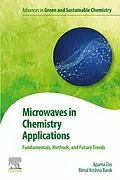Microwaves in Chemistry Applications: Fundamentals, Methods and Future Trends offers a number of benefits over conventional heating technologies, including acceleration of reaction rates, milder reaction conditions, higher chemical yields, lower energy usage and different reaction selectivity, all of which can improve the sustainability of processes. The book provides valuable insights into the underlying chemistry at play in microwave-assisted processes, introducing fundamental concepts, discussing the modeling of reactions in such processes, and also highlighting a range of key methods and applications of microwaves in chemistry for improved sustainability. Beginning with an introduction to microwave chemistry, Part One discusses foundational principles, equipment and approaches for modeling reactions and assessing the outputs of those models. Methods in microwave chemistry are then the focus of Part Two, with microwave-assisted synthesis, catalysis, reduction and reactions all explored in detail. Part Three reflects on the practical usage of these methods to address specific issues, covering a number of interesting applications. - Provides guidance on the modeling and interpretation of microwave effects - Discusses microwave chemistry in the context of green chemistry principles - Outlines a range of important microwave methods, including microwave-assisted synthesis, catalysis, reactions and reductions
Autorentext
Aparna Das
Assistant Professor, Department of Mathematics & Natural Sciences, Prince Mohammad Bin Fahd University, Kingdom of Saudi Arabia
Dr. Das is a physicochemist with extensive international research and teaching experience. She obtained a Ph.D. degree in material science/nanophysics from Joseph Fourier University, France based up on the work on semiconductor quantum dots for opto-chemical sensor application at Commissariat à l'énergie atomique (CEA), France. This work was developed within the EU project "Dotsense (FP7-ICT-STREP). Dr. Das's postdoctoral experiences include working as a scientist at the California NanoSystems institute and Electric Engineering Department, University of California, Los Angeles (UCLA), USA and as an Experienced researcher: Nanowiring-Marie Curie Initial Training Network at Georg-August-Universität Göttingen, Germany.
Dr. Das's research interests includes: Computer-assisted physico-chemical methods, interdisciplinary science (biology, chemistry and physics) for drug development, computer aided drug design, III-Nitride based chemical sensors, solar cells, optoelectronic devices, scanning electron microscopy, X-ray diffraction and Spectroscopy, thin layers and nanostructures (Quantum wells, quantum dots, nanowires). Her diverse research projects include identification of causes of bioactivity of molecules, calculation of energy of different reaction intermediates, and microwave-ultrasound-solar energy effects on chemical reactions.
Inhalt
1. Foundational principles of microwave chemistry
2. Microwave equipment for chemistry
3. Modelling and interpreting microwave effects
4. Microwave-assisted synthesis of oxygen and sulphur heterocycles
5. Microwave-assisted synthesis of nitrogen heterocycles
6. Microwave-Assisted Oxidation and Reduction Reactions
7. Microwave-Assisted Enzymatic Reactions
8. Microwave-Assisted Sterilization
9. Microwave-enhanced CVD processes for diamond synthesis
10. Future trends in microwave chemistry and biology
